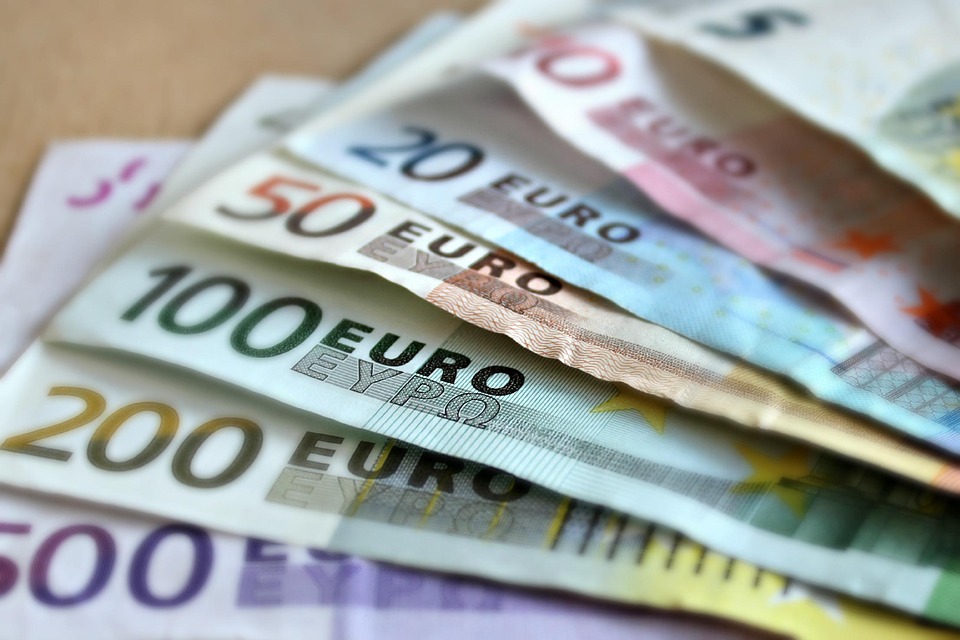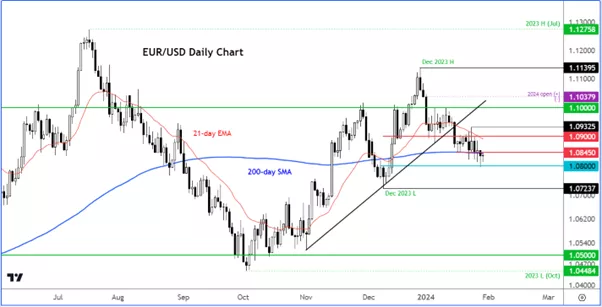EUR/USD Finds Some Respite As Focus Shifts To FOMC

Image Source: Pixabay
The EUR/USD has been falling in recent days with the dollar continuing to find support on the back of reduced expectations over a March rate cut. Despite this moderate bearish trend, I don’t expect to see a massive move lower in the EUR/USD exchange rate from current levels given that the hawkish repricing of the dollar is, or should be, mostly priced in by now. What’s more, the ongoing risk rally argues against a major sell-off in risk-sensitive currency pairs like the EUR/USD. So, I wouldn’t be surprised if the EUR/USD were to start showing some bullish characteristics again this week, despite all the doom and gloom about the Eurozone and the Middle East situation. For confirmation, though, we will need to see a bullish reversal pattern form on the daily chart of the EUR/USD, ideally around the 200-day moving average circa 1.0845/50 area, where this popular trading pair has been oscillating around for the past several days.
EUR/USD rebounds after dovish ECB talk
The EUR/USD was able to recover from early weakness by Tuesday’s mid-morning session in Europe. Most other euro crosses also bounced back with the EUR/GBP, for example, recovering to around 0.8550 after it had dropped to its weakest point on Monday since August. The single currency was hurt by dovish comments from a few ECB officials, advocating for a sooner rate cut. But on Tuesday morning the euro found support after data from the Eurozone’s second, third, and fourth largest economies were better than expected, alleviating concerns about the single currency block following the release of consistently poor data from Germany, the Eurozone’s economic powerhouse. The EUR/USD will remain in focus this week with the key US data on the agenda, while the US Federal Reserve decides on monetary policy.
German weakness offset by stronger data from Spain, Italy and France
We found out what everyone had expected: Germany’s GDP data showed the economic powerhouse remained out of fuel in the final quarter of 2023. The Eurozone’s largest economy contract by 0.3% q/q as expected. However, thanks to revisions to the previous quarter’s GDP data, a technical recession was avoided (i.e., two consecutive quarters of negative growth). Still, 2023 as a whole was poor, with output falling 0.3% year-over-year. That, by the way, was the first time since the height of the pandemic in 2020 that the German economy contracted on an annual basis.
As the weakness in German growth was fully priced in, the euro refused to fall further. In fact, we had better-than-expected data from the Eurozone’s second, third, and fourth largest economies: France, Italy, and Spain. These data releases alleviated concerns about the single currency block somewhat, and in doing so helped to push the EUR/USD back near the 200-day average and resistance in the 1.0845/1.0850 area.
Among the positive data surprises from the Eurozone, Spain’s economy expanded by a good 0.6% q/q compared to 0.2% expected and an upwardly revised 0.4% growth in Q3. Italy, too, saw its output beat expectations, coming at +0.2% q/q vs. zero expected and an upwardly revised +0.1% growth in the previous quarter. As a result, the Eurozone as a whole avoided a recession: although it didn’t expand, the flat performance was still better than a small contraction expected.
What’s more, Spain’s inflation was hotter at 3.4% vs. 3.0% expected and 3.1% last, which provides the ECB hawks even more reason to be cautious when it comes to lowering interest rates.
On top of this, France’s consumer spending came in better at 0.3% m/m vs. zero expected and 0.6% last.
Dovish ECB talks have limited influence on EUR/USD outlook
Tuesday’s slightly stronger eurozone data from outside of Germany suggests the ECB will be in no rush to start cutting rates, despite some dovish remarks yesterday made by some ECB officials.
On Monday, the EUR/USD dropped to below 1.08 handle for the first time since December, before bouncing back to close above this level. Its weakness was driven by dovish ECB talk as the likes of Peter Kažimír, Francois Villeroy de Galhau, and Mario Centeno all suggested that the central bank should cut rates sooner rather than later. However, ECB President Christine Lagarde was a bit more hawkish at the ECB press conference last week, even though she didn’t push back as forcefully as expected against market bets on a cut in the spring. Nevertheless, the ECB refused to provide any formal guidance. Most other policymakers in the institution have taken a more cautious stance, for example, Latvia’s Governing Council Member Martins Kazaks, who yesterday said the worst mistake would be to start lowering borrowing costs too early and allow inflation to return.
As most of the rate setters at the ECB appear to be in favor of waiting for wages data for May before deciding whether to cut rates, I doubt that the single currency will drop sharply further based on the dovish comments of a few members alone.
Still, those dovish remarks from a few officials didn’t stop investors on betting for a rate cut as soon as April. The dovish repricing commenced after Peter Kažimír, one of the more hawkish voices at the ECB, said that an interest rate cut is ‘within our reach’, while Mário Centeno advocated cutting rates sooner rather than later, and Governing Council member Francois Villeroy de Galhau signaled that the ECB could cut interest rates at any moment this year and all options are open at upcoming meetings: “Regarding the exact date, not one is excluded, and everything will be open at our next meetings.”
Traders’ focus turns to US data and FOMC
The dollar, bonds, and equity markets found support late in the day on Monday after forecasts from the US Treasury showed that its first-quarter net borrowing requirement would be $55 billion better than what it had predicted previously. This provides a better backdrop for Wednesday’s Quarterly Refunding announcement, which is why bond yields fell and tech stocks found fresh support at all-time highs, ahead of earnings from Microsoft stock, as well as Alphabet and AMD, on Tuesday after the bell.
All the attention will be on upcoming US data and the FOMC this week. I think that the upcoming FOMC meeting may not align with the prevailing dovish sentiment in the current market pricing. Since they unveiled their dot plot and staff forecasts in December, our main sources for policy insights will likely be the statement or press conference. Judging from recent remarks by the Fed, it seems improbable that they will adopt a dovish stance, posing a potential upward trajectory for the US dollar and bond yields. However, this will be expected by markets already. So, if they are even more hawkish than expected is what may give the dollar a more lasting support, while anything in line with expectations or slightly dovish should cause a bearish reversal for the dollar.
EUR/USD technical analysis
(Click on image to enlarge)

Source: TradingView.com
The EUR/USD remains contained inside small ranges ahead of the key events later in the week (see above). Short-term resistance is seen around 1.0845/50 area where we also have the 200-day moving average coming into play. Above this, 1.0900 is the next key resistance area. The bulls will be eying a clean break above 1.0900 in order to tip the balance back in their favor. The bears, meanwhile, will be eying the December low at 1.0723 next, should support at 1.0800 gives way in the next day or two.
As I mentioned earlier and to summarise, I anticipate that there won't be a substantial downward shift in the EUR/USD from current levels. The hawkish reassessment of the dollar is largely factored in at this point, and the persistent risk rally suggests a significant decline in risk-sensitive currency pairs like the EUR/USD is unlikely. Consequently, it wouldn't be totally unexpected if we were to witness bullish price action in the EUR/USD this week, despite concerns surrounding the Eurozone and the situation in the Middle East.
More By This Author:
EUR/USD rebounds as focus turns to ECB and key US dataGold Struggles Ahead Of A Busy Week
Global Stocks Plunge As Rate Cut Bets Trimmed
Disclaimer: The information on this web site is not targeted at the general public of any particular country. It is not intended for distribution to residents in any country where such ...
more


